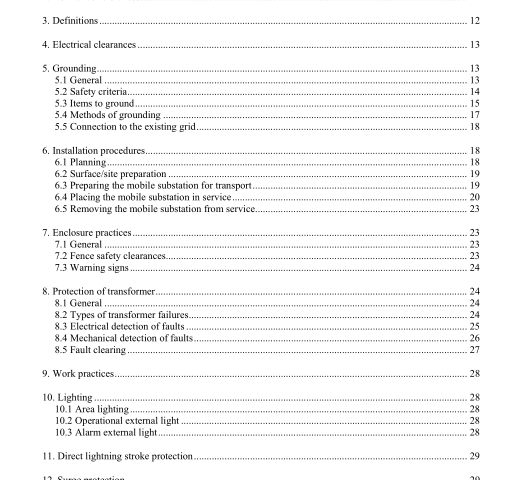IEEE 1268-2016 pdf download.IEEE Guide for Safety in the Installation of Mobile Substation Equipment
4. Electrical clearances
4.1 General Guarding and clearances to energized parts are given in Rule 124 of the 2002 (National Electrical Safety Code (NESC) [B1]) 5 for U.S. utilities. Users of this guide in other jurisdictions should review applicable local codes. Clearances to energized parts for safety of personnel are given in Table 124-1, “Clearances from Live Parts” of the 2002 2012 NESC unless adequate insulation or suitable barriers are provided. Rule 124A.3 of the 2002 2012 NESC states a minimum vertical clearance of 2.6m (8ft 6in) between any ungrounded part or parts of indeterminate potential and any permanent supporting surface where workers might stand. Temporary structures might be required to maintain proper clearances.
The user should review and refer to the applicable local codes and standards applicable to their installation. The following 4.2 Phase-to-ground and 4.3 refer phase-to the-phase clearances for those temporary connections required to install the mobile. These clearances will not be tested and therefore need to should follow the requirements of the NEC, ANSI C37.32-2002, etc. IEEE Std 1427™ 6 or any other jurisdictional codes. Tested devices such as the mobile substation (if tested) with its permanently installed equipment may have clearances that are less than those of the temporary connections required to place the mobile in service.
The numbers in brackets correspond to those of the bibliography in Annex A.
Information on references can be found in Clause 2.
5. Grounding
5.1 General IEEE Std 80™ provides general and specific guidelines for grounding substations and can be applied to mobile substation equipment. IEEE Std 81™ provides guidelines for the testing of grounding systems. This clause is intended to discuss specific items that need special emphasis or special treatment.
Mobile substations or transformer trailers might be installed in many locations. The trailers might be installed on utility property or non-utility property. On utility property, the mobile substation might be installed inside or outside the permanent substation fence. The mobile substation located outside the permanent substation fence might be located next to the substation, a distance away from the substation, on the transmission line right-of-way, or on non-utility property.
When the mobile substation is located outside the substation fence or on non-utility property, special attention needs to be given to the touch and step voltages at the mobile substation fence because it is the most likely point of contact by non-utility personnel. Transferred potential rise between the mobile (and its fencing, if applicable) and the substation needs to be managed. If the mobile substation must be energized before the fence and gate grounding and any necessary station counterpoise and high-resistivity ground cover described in this Guide are completed, it is advisable to create a nonconductive (e.g., with the brightly colored marker tape usually installed above underground cables) visual barrier on nonconductive supports well outside of any temporary fencing. In such cases, it may also be advisable to station temporary security personnel at the site to prevent public access and warn utility personnel of the fence hazard.
In all such events, the mobile substation equipment and trailer(s) shall be properly grounded before energizing as described herein, and every effort shall be made to finish the fence grounding, etc. before the end of the next day. Personnel touching or going inside the temporary fence and gate(s) and/or installing such grounding shall utilize personal protective equipment so as to guard themselves from hazardous touch potentials, and shall be properly trained as to the unusual hazards involved.IEEE 1268 pdf download.IEEE 1268-2016 pdf download
IEEE 1268-2016 pdf download

Leave a Reply